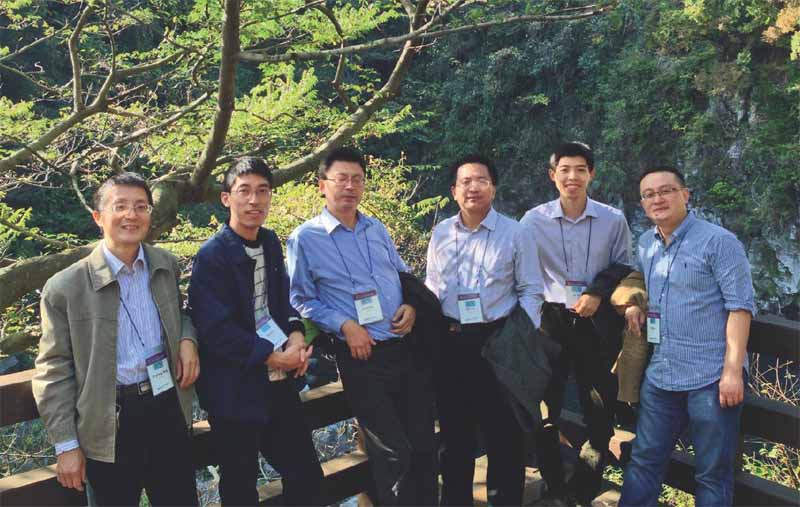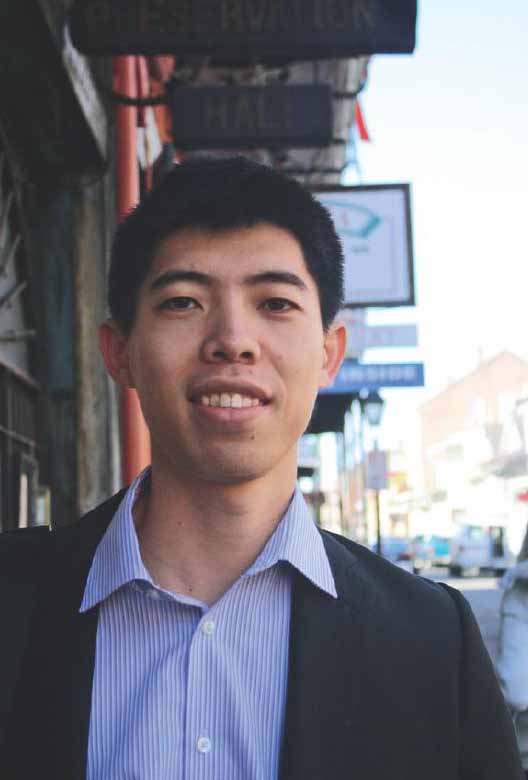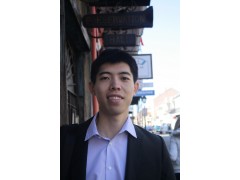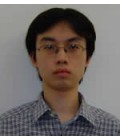專家信息:

林智,男,1980年11月30日出生,浙江大學應用數學研究所副所長,博士生導師。
教育及工作經歷:
1998--2002,華南理工大學, 應用數學系, 理學學士, 導師:郝志峰。
2002--2007,University of North Carolina (USA),數學系,博士,導師:R. McLaughlin / R. Camassa。
2007--2009,University of Michigan (USA), 數學系, 助理教授。
2009--2011,Institute of Mathematics and its Applications (USA), 研究員 。
2011至今, 浙江大學數學系,特聘研究員。
Professional Membership:
American Mathematical Society, Society for Industrial and Applied Mathematics,American Physical Society.
主講課程:
浙江大學 (Zhejiang University, Hangzhou, China):
《計算方法》 (Methods of Scientific Computation) (Spring/Summer '11-'14; Fall/Winter '15-'16)
研究生公選課程:《數值計算方法》 (Methods of Scientific Computation) (Fall '13-'15)
《常微分方程》 (Ordinary Differential Equations) (Fall '12-'15; Summer '13-'15)
《偏微分方程》 (Partial Differential Equations) (Winter '12-'15)
《博士生專業英語/LaTeX入門》 (Introduction to LaTeX) (Spring '14-'15)
U. of Michigan at Ann Arbor:
Spring 2009, Math 450: Advanced Mathematics for Engineers I Sample syllabus
Fall 2007 - Fall 2008, Math 471: Introduction to Numerical Methods Sample syllabus (PDF)
U. of North Carolina at Chapel Hill:
Fall 2006, Math 231 (Old 31): Calculus I: Functions of One Variable
Fall 2003, Math 230 (Old 30): Precalculus: Trigonometry and Analytic Geometry
Tutored and Assisted Courses:
Math 521 (Old 121): Advanced Calculus I
Math 547 (Old 147): Linear Algebra for Applications
Math 661 (Old 191): Scientific Computation I
研究方向:
偏微分方程,流體力學,漸近方法
Research Support:
1. Institute for Mathematics and its Applications, Minneapolis, Minnesota, USA.Postdoctoral Associate August 2009-present.
“Optimal Mixing and Biogenic Mixing", Institute for Mathematics and its Ap-plications: Thematic Year on Complex Fluids and Complex uids, Supported by National Science Foundation.
2. University of Michigan, Ann Arbor, Michigan, USA.Postdoctoral Assistant Professor.August 2007-May 2009
“Mixing e ciency of turbulent ows", Department of Mathematics, Supported by NSF award \Studies in Mathematical Physics: Advection, Convection and Turbulent Transport" (PHY-0555324).
3. University of North Carolina, Chapel Hill, North Carolina, USA.Research Assistant.September 2004-July 2007
“Scale dependent, heavy-tailed distributions in geophysical ows: physical mech-anisms and data assimilation", Department of Mathematics, Supported by NSF award \Collaborations in Mathematical Geosciences" (ATM-0327906).
4. Research Assistant.January 2004-January 2005.
“Turbulent jets and plumes in a strati ed environment", UNC Fluids Lab, De-partment of Mathematics.
科研成果:
1. Passive Scalar Intermittency
The mixing and transport phenomena in various fluids are often characterized by the behavior of fluctuation fields of submerged physical observables, many of which can be modeled as passive scalars, such as temperature, moisture, and chemical concentrations. "Passive" means that they do not affect the underlying flow. These quantities not only are the subject matters in environmental control, combustion, and biochemical reactions but also serve as proxies for the study of turbulence.
Scalar intermittency refers to the non-Gaussian scalar statistics widely observed in laboratory and field experiments. These "intermittent" probability distributions usually possess heavy tails indicating "anomalously" high probabilities for large and rare fluctuations than a normal distribution would suggest. In other words, they are inconsistent with the general Gaussian assumptions used, on account of their mathematical simplicity, in operational meteorology and climatology and they may drastically change the estimates concerning the current and future states of the environment.
R. Camassa, ZL and R. M. McLaughlin, Evolution of the probability measure for the Majda model: new invariant measures and breathing PDFs, Journal of Statistical Physics, 130(2): 343--371 (2008).
J. Bronski, R. Camassa, ZL, R. M. McLaughlin and A. Scotti, An explicit family of probability measures for passive scalar diffusion in a random flow, Journal of Statistical Physics, 128(4): 927--968 (2007).
(Resources: '07 UMich Talk; '07 MSRI Talk Video)
2. Mixing Measures
When it comes to describing how well-mixed a body of fluid is with some dye in it, there's really no concensus on what measure to use. Scalar statistics is one such measure; traditionally the mean-squared displacement of scalar particles is also one. Spatial variances are yet another common class which measures the homogeneity: after all, they are what we preceive looking at these pictures. Depending on the physics involved, the most natural measure to use and consequently, the mathematical challenges, approaches can vary.
Using different measures for the same problem sometimes can lead to conflicting and confusing results, while at other times, they can be complementary to each other and put together a comprehensive picture of the science. With a particular choice of the mixing measure, it's also possible to derive flow-control strategies are to optimize the flow-enhanced scalar mixing and transport in industrial applications like microfluidics.
E. Lunasin, E., ZL, A. Novikov, A. Mazzucato and C. R. Doering, Optimal mixing and optimal stirring for fixed energy, fixed power or fixed palenstrophy flows, Journal of Mathematical Physics, 53(11): 115611 (2012).
ZL, J.-L. Thiffeault and C. R. Doering, Optimal stirring strategies for passive scalar mixing, Journal of Fluid Mechanics, 675: 465--476 (2011).
ZL, K. Bodova and C. R. Doering, Models and measures of mixing and effective diffusion, Discrete and Continuous Dynamical Systems - A, 28(1): 259--274 (2010).
R. Camassa, ZL and R. M. McLaughlin, The Exact Evolution of the Scalar Variance in Pipe and Channel Flow, Communications in Mathematical Sciences, 8(2): 601--626 (2010).
(Resources: SIAM DS09 Talk, '10 UMN Talk)
3. Biogenic Mixing
Vertical mixing and transport in the ocean have always been central research topics for oceanographers and even more so for marine biologists. These mechanisms, by controlling the upwelling and sinking of nutrients/toxics and living species, play a vital role in almost all biological and chemical processes and eventually in the genesis and evolution of life on earth, especially in periods of climate change.
While the winds and tides have been naturally considered to be among the obvious driving forces, but: Do fish stir the ocean? And other marine species like whales and shrimps and planktons? Apparently their terrestrial and amphibious relatives such as earthworms and crabs are known to shape the geometry and composition of their surroundings. For decades scientists have been arguing about the significance of biogenic mixing in the oceans only based on some rough, top-down/energy budget/scaling calculations.
ZL, J.-L. Thiffeault and S. Childress, Stirring by squirmers, Journal of Fluid Mechanics, 669: 167--177 (2011).
(Resources: '10 IMA Poster, '11 ICIAM Talk; Coverage 1, 2 and 3 feat. JLT and SC)
4. Underwater Turbulent Plumes and Jets
The recent Deepwater Horizon blowout in the Gulf of Mexico caused catastrophic damages to the local ecology and human society. This is one prominent example of how a better knowledge of underwater turbulent plumes and jets would have saved billions (of lives). One huge problem after the crisis was that the oil plumes got trapped and spreaded below the water surface which made the skimming impossible. Knowing when and how this happened will provide valuable insights in environmental loss estimation and prevention.
R. Camassa, ZL and R. M. McLaughlin, Internal trapping of plumes in stratified environments, in preparation.
(Resources: UNC Experiment on Youtube; Coverage 1 and 2 feat. RMM and RC)
5. Multiscale and Stochastic Simulations
6. Homogenization and Asymptotic Methods
7. Parallel Computing with GPUs
代表性論文:
1 Lunasin, E., Lin, Z., Novikov, A. and et. al., Optimal mixing and optimal stirring for fixed energy, fixed power or fixed palenstrophy flows, Journal of Mathematical Physics, 53(11), 2012.(Top, SCI)
2 Adalsteinsson, D., Camassa, R., Lin, Z. and et. al, Subsurface Trapping of Oil Plumes in Stratification: Laboratory Investigations, Geophysical Monograph Series, 195, 2011.
3 Lin, Z., Thiffeault, J.-L. and Doering, C. R., Optimal stirring strategies for passive scalar mixing, Journal of Fluid Mechanics, 675, 2011.(Top, SCI)
4 Lin, Z., Thiffeault, J.-L. and Childress, S., Stirring by squirmers, Journal of Fluid Mechanics, 669, 2011.(Top, SCI)
5 Lin, Z., Bodova, K. and Doering, C. R., Models and measures of mixing and effective diffusion, Discrete and Continuous Dynamics Systems - A, 28(1), 2010.(Top, SCI)
6 Camassa, R., Lin, Z. and McLaughlin, R. M., The exact evolution of the scalar variance in pipe and channel flow, Communications in Mathematical Sciences, 8(2), 2010.(SCI)
7 Camassa, R., Lin, Z. and McLaughlin, R. M., Evolution of the probabilitymeasure for the Majda model: new invariant measures and breathing PDFs, Journal of Statistical Physics, 130(2), 2008.(SCI)
8 Bronski, J. C., Camassa, R., Lin, Z. and et. al., An explicit family of probability measures for passive scalar diffusion in a random flow, Journal of Statistical Physics, 128(4), 2007.(SCI)
Invited Presentations:
1. “Mixing and Transport of Passive Scalar in Fluids", Institute of Natural Sciences,Presentations Shanghai Jiao Tong University, Shanghai, China.November 2011
2. “A Simple Model for Biogenic Mixing", Applied Math Seminar, Guangdong Uni-versity of Technology, Guangzhou, China.September 2011
3. “A Stochastic Hydrodynamic Model for Biogenic Mixing", International Confer-ence on Interdisciplinary, Applied and Computation Mathematics, Zhejiang Uni-versity, Hangzhou, China.June 2011
4. “Optimal Mixing", The 63rd Annual Meeting of Division of Fluid Dynamics,American Physical Society, Long Beach, CA.November 2010
5. “Calculus of Variations and its Applications in Mixing", Minnesota Undergraduate Math Club, University of Minnesota, Minneapolis, MN.March 2010
6. “Mathematical models and measures of mixing", IMA Postdoc Seminar, Min-neapolis, MN.November 2009
7. “Measures of mixing and e ective di usion", SIAM Conference on Applied Dy-namical Systems, Snowbird, UT.May 2009
8. “Passive scalar intermittency in random ows", Applied and Industrial Math Sem-inar, University of Michigan, Ann Arbor, MI.February 2008
9. “The Majda model and scalar intermittency in random ows", SIAM Conference on Applied Dynamical Systems, Snowbird, UT.June 2007
10.“ Simple models of passive scalar intermittency", Mathematical Issues in Stochastic Approaches for Multiscale Modeling, MSRI, Berkeley, CA.May 2007
11. “Passive scalar intermittency in random ows", Applied Mathematics Lab Semi-nar, Courant Institute, New York, NY.February 2007
12. “Non-Gaussianity in turbulent transport", Southeastern Atlantic Mathematical Sciences Workshop, College of Charleston, Charleston, SC.September 2006
13. “An explicit family of probability measures for passive scalar di usion in a random ow", AIMS' Sixth International Conference on Dynamical Systems, Di erential Equations and Applications, University of Poitiers, Poitiers, France. June 2006
14. “The spatio-temporal evolution of the probability density function for a passive scalar advected by a rapidly varying random wind", Southeastern Atlantic Mathe-matical Sciences Workshop, University of North Carolina, Chapel Hill, NC. Septem-ber 2005
15.(Poster) “A Hydrodynamic Model of Biogenic Mixing", IMA Workshop for Natural Locomotion in Fluids and on Surfaces: Swimming, Flying, and Sliding, University of Minnesota, Minneapolis, MN. June 2010
16.(Poster) “Full PDF reconstruction from exact statistical moments of the advection-di usion of a passive tracer in a random ow", SIAM Conference on Applied Dy-namical Systems, Snowbird, UT.May 2005
17.(Poster) “Plume mixing and entrainment in a strati ed environment", Southeast-ern Atlantic Mathematical Sciences Workshop, College of Charleston, Charleston, SC September. 2004
榮譽獎勵:
1. Postdoctoral Summer Research Fellowship, University of Michigan 2008
2. Scholars for Tomorrow Fellowship, University of North Carolina 2002-2004
3. Dissertation Fellowship, South China University of Technology 2002
4. Meritorious, The Mathematical Contest in Modeling, COMAP 2001
5. Second Prize, Contemporary Undergraduate Mathematical Contest in Modeling,CSIAM 2000
6. Annual Collegiate Scholarship, South China University of Technology 1999 -2001
Meetings:
1. Organizer, Minisymposium on Mixing in Geophysics and Engineering, SIAM Conference on Applications of Dynamical Systems, Snowbird, UT May 22-26,2011.
2. Organizer, Minisymposium on Optimal Mixing, The 7th International Congress on Industrial and Applied Mathematics, Vancouver, BC, Canada July 18-22,2011.
Committees:
Chair, Fundraising Team, Chinese Scholars and Students Association, University of Michigan 2009
曾受到美國工業與應用數學協會(SIAM)、美國國家數學研究所(MSRI)、純數學與應用數學研究所(IPAM)等組織資助和邀請在中國、美國、法國和加拿大等地作專題報告。
2011年5月與7月分別于SIAM動力系統雙年會及四年一度的國際工業及應用數學大會(ICIAM 2011)各組織了一次有關混合輸運的專題研討會。

林智,浙江大學應用數學研究所副所長。主要從事流體力學問題驅動的應用數學和計算數學研究。發表Top、SCI收錄論文8篇。曾獲美國北卡羅萊納大學“明日學者”獎學金, 2008年暑期獲美國密歇根大學博士后研究資助項目。回國之后,已在短時間內和新成立的浙大海洋科學和工程系、國家海洋局第二海洋研究所的相關科研人員開展了穩定廣泛的學術交流。
“數學是透視世間萬象的工具”,用這句話來形容林智對數學的認識,既貼切又恰當。
作為一名科研人員,他有著對埋頭實驗室做科研的癡迷;作為一個社會人士,他又充滿著對世間萬物強烈的好奇。他試圖用鐘愛的數學理論去解構這個世界,把枯燥的論理與世間的繁蕪融合起來,化復雜為簡單。
他把數學中的偏微分方程、隨機過程、漸近方法、變分法、數值模擬等數學理論和工具應用于海洋世界、城市污染防控及各項交叉學科當中,取得諸多原創性成果,得到國內外認可的同時,他并未停下科研的腳步,仍繼續把“應用數學”這一學科的價值發揮到實處。
他就是浙江大學應用數學研究所副所長林智,一位青年導師。
從數學到流體力學
1998年,林智就來到華南理工大學應用數學系,從此叩開了數學世界的大門。2002年,他去美國北卡羅萊納大學讀博,一次機遇讓他的科研軌跡開始轉向。
“在美國攻讀博士期間,由于二年級時進入了由Richard McLaughlin和Roberto Camassa兩位教授主持的“應用數學及海洋科學聯合流體力學實驗室”擔任助教,主要指導本科生進行實驗研究和整理數據,自此對流場中的各種混合輸運問題產生了濃厚的興趣”。
于是,林智選擇了McLaughlin和Camassa兩位教授作為論文導師,并在美國自然科學基金會“數學與地球科學協作”(CMG)項目的資助下進行博士階段的學習。從此,正式進入流體力學科研領域。
“萬物皆數”——古希臘數學家畢達哥拉斯的這句話固然過于夸張,但林智始終相信,數學的魅力就在于它的抽象理論應用能夠揭示各種現象和問題的本質,讓人們發現這個世界的精彩。
林智在前人研究基礎上,認為在流場中“混合輸運建模分析能夠幫助我們了解自身所處生存環境的變化規律,同時能夠在實踐工程中預測、防控這一類過程,而且在經典流體問題——比如刻劃湍流和混沌的特征和形成機制的研究上,也是常用的數學手段”。
從2005年開始,林智就在利用類Sobolev多尺度測度和概率工具刻劃混合輸運、建立廣義彌散—擴散模型、對混合輸運作變化法優化控制等方面積極探索,取得到一些原創性成果。
流場中混合輸運方面的系列研究,讓林智建立了全面的數學建模思想體系。之后,他開始把眼光轉向了更為真實、復雜的海洋世界。
解構海洋世界
海洋,遼闊而又深邃。自古以來,人類從未放棄對海洋世界的探索。從遠古時期的魚鹽之利、舟楫之便,到航海時代的戰略要塞、運輸渠道,再到現代文明的深度利用、服務社會,海洋的應用價值被逐漸提升,蘊藏在海洋中的豐富資源被逐一發掘。
近年,隨著海洋經濟步伐的持續加快,海洋環境的保護之聲日漸迭起。因此,更好地了解海洋環境、利用海洋中數量龐大的生物資源,就成為新時代海洋發展戰略中的關鍵一環。
癡迷于流場中混合運輸問題的林智認為,“微小生物個體的流動產生混合輸運,已經成為多個學科領域專家所關心的問題”。在這種局面下,要與地球科學、生化醫藥和工程控制等交叉學科科研人員展開聯合研究。
2010年起,林智就把數學建模思想應用在了海洋中生物資源模擬上。
他尋找到志同道合的人,共同建立了模擬生物體游動產生標量混合輸運的首個隨機流體力學模型。原創性地刻畫了稀疏生物個體隨機游動產生的統計力學問題,并導出了同時適用于勢流場和Stokes流場的等效擴散系數公式。
在主持的國家自然科學基金青年基金項目“標量混合輸運的統一測試分析、仿真及優化控制”時,面對復雜流下標量的混合輸運的混合測試問題,基于混合輸運問題的多尺度、多機制特性,他探索出一種能應用在各種尺度和物理圖景、具有廣適性的統一混合測度,并在此基礎上建立數學模型和導出優化控制策略,揭示了混合輸運現象的本質和規律,同時為標量混合的科學和工程實踐提出了最大利益化模型。
通過直觀地引入類Sobolev范數的多尺度混合測度,基于經典熱擴散方程進行的廣義偏微分方程建模,他得到了在混合程度上與精確解等價的等效標量分布……這一系列原創性成果,具備更好的廣適性,在國內外引起強烈反響。
回國短短幾年,林智就與浙江大學海洋科學和工程系、國家海洋局第二海洋研究所展開合作,建立了長久的合作關系,開展了穩定廣泛的學術交流,為今后海洋流體問題的全方位研究,搭建了更加堅實的科研平臺。
大數據下的城市建模
流體,不僅僅只局限于海洋。
隨著城市化建設的腳步加快,各色污染物大量涌現,對空氣、土壤產生了極大威脅,嚴重阻礙了各大城市的良性發展。
“我希望數學能夠突破原有框架,為人類發展服務”。2014年,浙江大學與帝國理工大學成立“聯合數據科學實驗室”,這為從不拘泥于實驗室做科研的林智帶來了一個契機,他開始從反問題的角度,研究考察城市環境內各種污染物的生成、傳播和控制問題。
縱觀我國科研領域近幾十年的發展,有關反問題的理論研究、數值計算和分析方法一直備受重視,例如在一些國家重大戰略需求的科學領域和工業研究中(如工業、環境監測、醫學診斷、設備安檢、地質勘探等)均廣泛應用。尤其是以數學為中心,聚集了大量物理、化學、材料、醫學、環境、計算機等多學科、多領域的科學家,早已開展了深入的交叉合作。
基于此,他積極參與了兩項國家自然科學基金項目——“應用反問題的建模與計算”和“反問題的數學建模、計算及應用”。項目結合英方的高性能數值算法和浙大數學系團隊的反問題方面的建模成果,展開了研究。一方面,通過對正問題的研究評價和預測污染物的影響;另一方面,能過反問題的研究反演介質參數、污染源位置和強度等性質,進而對污染進行優化控制。
這項具有原創性新思路的探索研究,整合了建模、算法及數值模擬多個層面,真正發揮出了數學基礎理論在交叉學科研究中的作用,為我國城市化發展進程中出現的污染問題,提出了良好的防控方案。
世界復雜,萬物多樣。無論是海洋生物演進,還是現代城市文明建設;無論是自然流體運動,還是人為污染物的漂移,都是社會發展進程中的諸多現象之一。他一直致力于用基礎的數學模型解構它們,了解各個現象機理,從而尋找到人類與自然和諧相處的關鍵點,為現代文明的長遠發展服務。我們期待他帶來更多的精彩。
來源:科學中國人 2015年第11期
中國科技創新人物云平臺暨“互聯網+”科技創新人物開放共享平臺(簡稱:中國科技創新人物云平臺)免責聲明:
1、中國科技創新人物云平臺是:“互聯網+科技創新人物”的大型云平臺,平臺主要發揮互聯網在生產要素配置中的優化和集成作用,將互聯網與科技創新人物的創新成果深度融合于經濟社會各領域之中,提升實體經濟的創新力和生產力,形成更廣泛的以互聯網為基礎設施和實現工具的經濟發展新形態,實現融合創新,為大眾創業,萬眾創新提供智力支持,為產業智能化提供支撐,加快形成經濟發展新動能,促進國民經濟提質增效升級。
2、中國科技創新人物云平臺暨“互聯網+”科技創新人物開放共享平臺內容來源于互聯網,信息都是采用計算機手段與相關數據庫信息自動匹配提取數據生成,并不意味著贊同其觀點或證實其內容的真實性,如果發現信息存在錯誤或者偏差,歡迎隨時與我們聯系,以便進行更新完善。
3、如果您認為本詞條還有待完善,請編輯詞條。
4、如果發現中國科技創新人物云平臺提供的內容有誤或轉載稿涉及版權等問題,請及時向本站反饋,網站編輯部郵箱:kjcxac@126.com。
5、中國科技創新人物云平臺建設中盡最大努力保證數據的真實可靠,但由于一些信息難于確認不可避免產生錯誤。因此,平臺信息僅供參考,對于使用平臺信息而引起的任何爭議,平臺概不承擔任何責任。

















